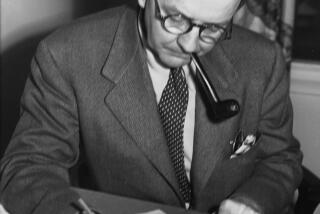Bell Lettres : SELECTED LETTERS OF VANESSA BELL, <i> Edited by Regina Marler (Pantheon Books: $35; 593 pp.)</i>
- Share via
Bloomsbury. Has any other cultural coterie of our time been under such unrelenting scrutiny? Faced with its continuing charisma one conjures up an Edwardian model of People magazine that would have devoted an eight-page spread to the peccadilloes of these supposed social voluptuaries. The enlightened literati who spearheaded an aesthetic revolt against Victorian staidness and hypocrisy are due to their fame reduced to glitterati whose deeds and misdeeds will be savored like so many yummy canapes of scandalous gossip.
Today, a Merchant/Ivory film seems the more appropriate medium for a Bloomsbury entertainment. And from the evidence presented in “Selected Letters of Vanessa Bell,” it is she and not her famed sister, Virginia Woolf, who would have the lead role.
In the introductory essays to this previously unpublished correspondence editor Regina Marler implicitly and correctly places Vanessa Bell at the group’s center--not so much regnant queen bee as quietly unifying presence. In what is a paradigm of scholarship Marler’s scrupulous notes provide a spare biographical complement necessary to a full understanding of the letters. Such transitional bonding is easy to take in because the notes are situated on the pertinent pages themselves and not relegated to the back of the book.
Bell’s letters can be read as an epistolary history of Bloomsbury. They make narrative sense and connect what was a loose confederation of writers, painters, economists and philosophers of common background and shared values. Briefly summarized, they were educationally related (mostly Cambridge), financially comfortable though not rich, connected by family or romantic liaison, politically indifferent for the most part to the prevailing ambitions of the British Empire, modernistic in their approach to the making of art, and sexually liberated (though essentially not promiscuous).
At the age of 25 upon the death of her parents, Bell relocated herself and her three younger siblings from Tony Kensington to bustling Bloomsbury in west central London. There, from the house at 46 Gordon Square, not far from the British Museum, she ran a household that in time became a central gathering place for her bright and creative friends.
She was the sort of woman who managed to remain on intimate terms with all her lovers--the francophile art critic, Clive Bell, whom she married, whose name her children took, and with whose aesthetics she began; art theoretician Roger Fry with whom she had a passionate fling, and whose provocative ideas on art would affect her own; the primarily gay Duncan Grant who would become her true life’s companion, with whom she painted, mounted art exhibitions and had her last child.
With Fry and Grant she founded the Omega Workshops, a bold and influential cultural experiment that reshaped English ideas of interior decoration and furniture design. She became a painter of note as well as an innovative designer of book covers, chiefly those of Leonard and Virginia Woolf’s Hogarth Press. She raised her children in an ambience of social freedom and enduring maternal love.
If we understand the term feminist to mean a woman’s survival on equal terms in a male-dominated society, then Bell was one, although not of the strident, polemicizing variety. In her work and in her personal relationships she functioned by candid and serene example.
A century ago letter writing was a leisurely pursuit whereby one’s ideas and feelings could be communicated with unhurried grace. Such a humanist style was made to order for Vanessa. One wonders how she would have functioned in today’s depersonalized world of terse phone and fax messages.
Bell tended to denigrate her own writing skills, often comparing her unadorned prose style unfavorably with Woolf’s. These heartfelt letters, with their tonalities of sympathy and good sense, prove her wrong. High-flown figures of speech are seemingly avoided in favor of clarity. Marler points out that Bell and Woolf tacitly agreed to each other’s turf--one that of a pictorialist, the other of a wordsmith. Perhaps because of this reluctance to regard herself as a finished writer, Bell’s letters do not readily lend themselves to excerpting. Each missive has its own gestalt.
“As none knows better than you,” she wrote to Woolf, “only human news makes interesting letters, so don’t expect much from me.”
Expectations aside, with this volume Vanessa Bell, perhaps the most integral of all the “Bloomsberries,” delivers the goods.
More to Read
Sign up for our Book Club newsletter
Get the latest news, events and more from the Los Angeles Times Book Club, and help us get L.A. reading and talking.
You may occasionally receive promotional content from the Los Angeles Times.










